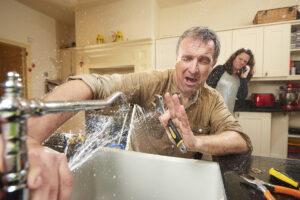
We have some tips to help you avoid common plumbing mistakes during DIY projects around your home.
When taking on DIY home improvement projects, it’s easy to overlook the potential impact on your plumbing. Whether you’re installing new flooring, putting up drywall, or renovating a bathroom, even small oversights can lead to big plumbing issues. Since many essential pipes and fixtures are hidden behind walls, floors, or ceilings, it’s crucial to stay mindful of how your DIY projects can affect them.
Neglecting to Locate and Protect Plumbing Lines
Many DIY projects involve drilling, hammering, or cutting into walls, floors, and ceilings, which can accidentally damage hidden plumbing lines. Water pipes, especially those made of copper or plastic, are susceptible to punctures or breaks from nails, screws, or saw blades. Damaging a water line can lead to significant water damage and costly repairs.
Solution: Use a stud finder with plumbing detection features, or consult your home’s blueprints if available. Before drilling or cutting, always check for nearby pipes, and mark their locations to avoid accidental hits. In areas where pipes are close to the surface, consider installing metal plates over the studs to protect them.
Not Shutting Off the Water Supply When Necessary
Many DIY projects, such as installing a new sink or toilet, involve working close to water supply lines. Failing to turn off the water supply before you start can cause unexpected flooding or leaks, leading to water damage.
Solution: Always locate and shut off the water supply to the specific area you’re working on. If you’re uncertain about which valves control the water for your project, turn off the main water supply to the house. Once the water is off, turn on a faucet to release any remaining pressure in the pipes.
Improperly Installing Flooring Near Water Lines
When installing new flooring, particularly in kitchens, bathrooms, or laundry rooms, ensure that the work does not compromise any existing plumbing. Flooring can affect appliance levels, restrict access to plumbing fixtures, or trap pipes in a way that makes them difficult to reach. Improperly installed flooring can lead to water pooling under the surface, which may eventually cause damage to both the flooring and the plumbing.
Solution: Before laying down flooring, check that any nearby appliances, such as dishwashers and washing machines, have proper access to their water connections. Additionally, ensure your new flooring has adequate water-resistant properties if it’s being installed in a high-moisture area. Use waterproof materials where possible, especially around water-prone areas like under sinks.
Blocking or Covering Access Points for Plumbing Maintenance
During renovations, many people cover or enclose plumbing access points, such as shutoff valves and cleanouts, with drywall or cabinetry, making it challenging to perform future maintenance. These access points are essential for quick repairs, such as turning off water or clearing clogs.
Solution: Plan your design to keep access points clear. If you must build around these areas, consider installing removable panels or doors to allow future access. For instance, a small, discreet access panel can blend in with the wall but still allow you to reach the plumbing when needed.
Overloading Cabinets or Vanities with Heavy Materials
Cabinet upgrades are a popular DIY project, but overloading them with heavy materials, such as granite countertops or dense shelving, can place strain on plumbing fixtures located underneath. Pipes under sinks, for example, can become stressed or even loosened over time from the added weight or restricted access.
Solution: When installing heavy materials, double-check that the weight won’t affect the plumbing underneath. Reinforce cabinets as needed and make sure that pipes are properly secured. Leave enough clearance for easy access to valves and connections.
Altering Bathroom or Kitchen Layouts Without Considering Plumbing Routes
When planning a DIY layout change for a bathroom or kitchen, it’s important to remember that plumbing routes may limit your options. Moving a sink, toilet, or dishwasher without considering existing plumbing connections can lead to inefficient layouts or even costly rerouting of pipes.
Solution: Consult a plumber or look at your home’s plumbing plans before committing to any major layout changes. Knowing where pipes are located will help you plan an efficient design that avoids unnecessary or costly modifications.
Call Mahon Plumbing Today
If you still have more questions regarding your plumbing, we here at Mahon Plumbing are here to help. We have been serving the wider Baltimore area since 1994, so we have 25 years of experience to back up our fantastic service! Call us at our Baltimore location at 410-766-8566 or our Pasadena location at 410-636-7944. Be sure to keep up with us on social media by following us on Facebook or Twitter.
